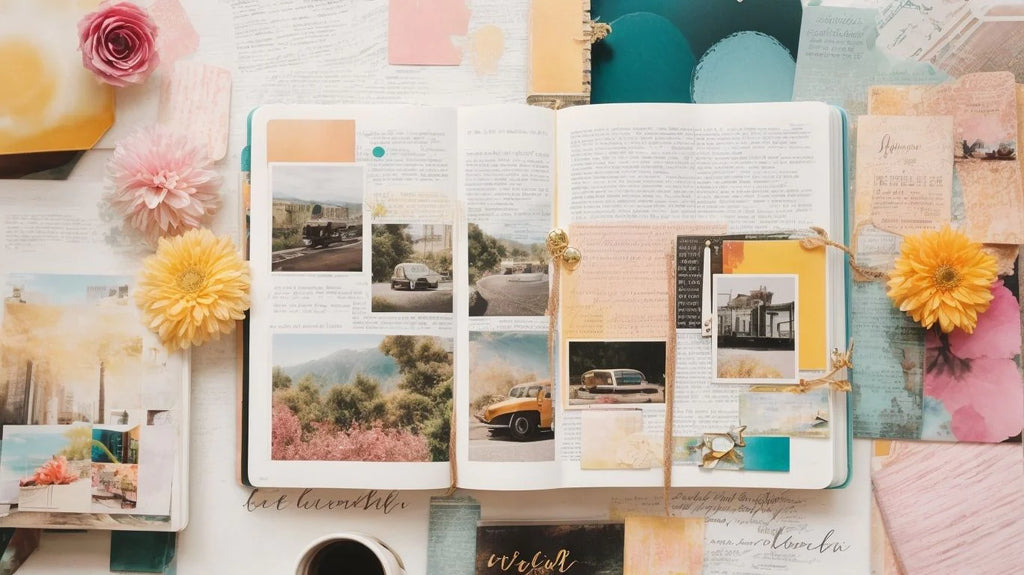7 Scrapbooking Journaling Ideas and Tips for Beginners
What Is Scrapbooking Journaling?
Scrapbooking journaling is the practice of artistically recording memories and stories through a combination of photographs, decorative elements, and personal narratives. It adds depth and context to the preserved moments, transforming them into treasured keepsakes. Whether it's a brief caption, a detailed account, or a heartfelt letter, journaling in scrapbooking captures the essence of the depicted events, enhancing the overall storytelling experience.
Pro-tip: When journaling for scrapbooking, be sure to use acid-free pens and markers to ensure the longevity of your written memories.
Why Is Journaling Important in Scrapbooking?
Journaling is an essential aspect of scrapbooking as it adds depth and context to your memories, making them more meaningful and long-lasting. It captures the emotions and stories behind the photos, providing valuable insights into your life and experiences for future generations.
When I was scrapbooking my family vacation photos, I made sure to include journaling about our spontaneous adventures and the laughter we shared. Years later, reading those entries brought back vivid memories and strengthened our family bond. This is why journaling is crucial in scrapbooking - it helps preserve and enhance the memories captured in the photos.
7 Tips To Get Started With Scrapbooking Journaling

For those new to the world of scrapbooking, the idea of combining journaling with art and photos can seem overwhelming. But fear not, with these helpful tips, you'll be well on your way to creating beautiful scrapbook pages filled with personal stories and memories. Let's dive into the first step: choosing a theme or story to focus on. This will serve as the foundation for your entire scrapbook and help guide your journaling and design choices.
1. Choose a Theme or Story to Focus On
- Reflect on significant life events or experiences.
- Consider emotions, such as love, loss, or achievement, as themes.
- Focus on a specific period, like a memorable vacation or family celebration.
- Document personal growth, challenges, or lessons learned.
- Highlight hobbies, passions, or special interests as the central story.
Once, I decided to center my scrapbook around a specific theme: my grandmother's culinary legacy. I collected her handwritten recipes, photos of our family meals, and stories about our time in the kitchen. It was a meaningful journey capturing her love for cooking and the traditions she passed down to us.
Time to channel your inner hoarder and gather all the scrapbooking goodies you've been secretly stashing away.
2. Gather Your Materials
- Choose a theme or story to focus on
- Gather Your Materials, including patterned paper, stickers, die-cuts, and embellishments
- Write in your own voice, expressing your thoughts and feelings
- Use creative writing techniques such as descriptive language and metaphors
- Incorporate photos and memorabilia that resonate with the theme
- Experiment with different styles of journaling, from free-form to structured formats
- Don't be afraid to make mistakes, as they can lead to creative discoveries
Remember, gathering your materials is a crucial step in scrapbooking journaling. Be sure to collect items that inspire your creativity and reflect the story you want to tell.
Remember, it's your journal, so write like no one's reading...unless you want them to.
3. Write in Your Own Voice
- Express authentically: Write from your heart, conveying genuine emotions and thoughts.
- Avoid imitation: Embrace your unique style and tone, steering clear of mimicking others' voices.
- Be honest: Share personal experiences and insights, maintaining transparency and sincerity.
When writing in your own voice, remember to be true to yourself, allowing your personality to shine through your words. Avoid overthinking and simply let your authenticity flow onto the pages.
4. Use Creative Writing Techniques
- Brainstorming: Generate ideas by freewriting or mind mapping to kickstart your creative writing process.
- Imagery and Descriptions: Use vivid descriptions and sensory details to make your journaling come alive.
- Metaphors and Similes: Infuse your writing with figurative language to add depth and creativity.
- Dialogue: Incorporate conversations or inner dialogues to bring a personal touch to your journaling.
- Poetic Devices: Experiment with poetic techniques such as alliteration, rhythm, and rhyme for a unique writing style.
5. Incorporate Photos and Memorabilia
- Choose meaningful photos and memorabilia that relate to your scrapbook theme or story.
- Organize and arrange the selected photos and memorabilia in a visually appealing manner.
- Consider using photo corners, adhesive mounts, or washi tape to secure the photos and memorabilia.
- Write captions or short descriptions to accompany the photos and memorabilia, adding context and personal touch.
- Protect fragile or valuable memorabilia by using acid-free and archival-safe materials.
When incorporating photos and memorabilia into your scrapbooking, make sure to include each element in a way that contributes to the overall narrative and evokes emotions and memories.
6. Experiment with Different Styles
- Explore various writing styles such as narrative, descriptive, or reflective to discover the one that best suits your storytelling.
- Experiment with different fonts, sizes, and colors to add visual interest to your journaling.
- Try out mixed media techniques like collaging, stamping, or stenciling to enhance the visual appeal of your scrapbook journaling.
- Consider integrating digital elements and hand-written entries for a personalized touch.
Embrace the process of experimenting with different styles to find your unique journaling voice and artistic expression.
Embrace the imperfections and call it 'scrapbooking charm' - your mistakes might just be your best pieces.
7. Don't Be Afraid to Make Mistakes
- Embrace imperfections as part of the creative process.
- View mistakes as learning opportunities.
- Experiment with different techniques and styles.
- Seek inspiration from others' work.
- Stay open to trying new approaches.
Remember, 7. Don't be afraid to make mistakes; they can lead to unexpected and beautiful outcomes in your scrapbooking journaling journey.
Unleash your inner artist and tell your story through lists, letters, and even song lyrics in your scrapbooking journal.
7 Scrapbooking Journaling Ideas
Journaling is an essential part of scrapbooking, as it allows us to add personal touches and narratives to our pages. But sometimes, coming up with journaling ideas can be a challenge, especially for beginners. In this section, we'll discuss seven creative journaling ideas for scrapbooking that will add depth and meaning to your layouts. From creating a timeline to incorporating art and handwriting, these tips will help you tell your stories in a unique and creative way.
1. Create a Timeline
- Choose the theme or event for your timeline.
- Gather relevant photos, memorabilia, and documents.
- Arrange the items chronologically to depict the sequence of events.
- Add journaling to provide context and details for each milestone or moment.
- Incorporate creative elements, such as stickers, drawings, or themed embellishments, to enhance the timeline.
We all love a good list, especially when it involves ranking our crafting supplies and snacks.
2. Make a List or Top 10
- Create a top 10 list of favorite memories from a recent vacation.
- Make a list of the top 10 things you love about a family member or friend.
- Compile a top 10 list of books that have had a significant impact on your life.
- Document a top 10 list of personal goals for the upcoming year.
- Create a top 10 list of favorite recipes or meals that hold special meaning to you.
Get ready to channel your inner Taylor Swift or Shakespeare with this creative journaling tip!
3. Use Quotes or Song Lyrics
- Choose meaningful quotes or song lyrics that align with the theme of your scrapbook page.
- Consider the emotional impact of the selected quotes or lyrics and how they enhance the story you're sharing.
- Write out the quotes or lyrics neatly or use creative lettering to add visual interest.
- Incorporate the quotes or song lyrics with the photos and other elements on the page to create a cohesive visual narrative.
- Pro-tip: When using song lyrics, be mindful of copyright laws, and consider using only a few lines or obtaining permission if necessary.
Get ready to put your inner Shakespeare to shame with these creative journaling ideas for scrapbooking.
4. Write a Letter
- Choose the recipient and purpose of the letter.
- Set the tone and style, whether it's formal, casual, or heartfelt.
- Start with a meaningful greeting and introduce the main content.
- Express thoughts, feelings, and experiences effectively while writing the letter.
- Include specific details and memories to personalize the letter.
- Conclude with a thoughtful ending and sign the letter.
Get ready to unleash your inner storyteller and turn your scrapbook into a best-selling novel (or at least a New York Times best-seller).
5. Tell a Story
- Begin with a captivating introduction to immediately grab the reader's attention.
- Develop the characters, setting, and plot to create a compelling narrative.
- Incorporate emotions and sensory details to fully engage the readers in the story.
- Create a conflict or challenge that drives the story forward and keeps the readers invested.
- Provide a resolution or lesson learned for a satisfying and fulfilling conclusion.
6. Use Prompts or Journaling Cards
- Prepare Prompts: Create a set of prompts related to your scrapbook theme or story, such as childhood memories, travel adventures, or family traditions.
- Choose Journaling Cards: Select visually appealing journaling cards to enhance your scrapbook layout and provide space for writing.
- Personalize Prompts: Customize the prompts to evoke specific memories or emotions associated with the photos and memorabilia you're including in your scrapbook.
- Use Variety: Experiment with different types of prompts and journaling cards to add diversity and interest to your scrapbook pages.
7. Incorporate Art or Handwriting
- Prepare your materials: Gather art supplies, such as colored pencils, markers, and watercolors, along with handwriting tools like calligraphy pens or fine-tip markers.
- Choose a focal point: Decide on the central art or handwriting element for your page, whether it's a sketched border, hand-lettered title, or painted background.
- Practice different styles: Experiment with various art techniques and handwriting styles to find what best complements your scrapbook theme.
- Combine art and text: Integrate your handwritten journaling with artistic elements like doodles, sketches, or mixed media for a visually appealing layout.
- Personalize with creativity: Add a unique touch to your scrapbook by incorporating your artistic flair and handwritten sentiments.




















